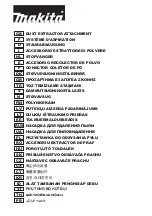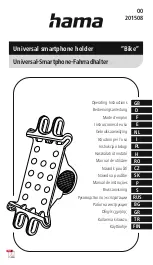
Microscopy
Hint: Correctly align the slit aperture on the NAMC module to a pattern on the focusing surface of the NAMC objective
(the
modulator).
1) Adjust the microscope for the bright-field microscopy. (See the instruction manual supplied with the microscope.)
2) Bring the NAMC 10x objective into the optical path.
3) Rotate the condenser turret to the position “NAMC1”.
4) Fully open the condenser aperture diaphragm.
On modulation contrast microscopy, always fully open the condenser aperture diaphragm to let the enough light pass
through the slit aperture on the NAMC module.
5) Focus on the specimen.
6) Adjust the correction ring on the NAMC objective. (See the instruction manual supplied with the microscope.)
7) Rotate the Bertrand lens in/out lever on the eyepiece tube to the position “B” to bring the Bertrand lens into the optical path.
If your eyepiece tube does not have a Bertrand lens, remove one eyepiece and insert the centering telescope instead.
8) Rotate either the Bertrand lens focusing screw or the eyepiece part on the centering telescope to focus on both the exit
pupil of the NAMC objective (the modulator) and the slit aperture image of the NAMC module.
The view of the modulator
Observe a dark region D at one edge, a narrow gray region G, and a large
bright region B on the exit pupil of the NAMC objective (= modulator).
(Figure 3)
The contrast is attained in the direction shown by the arrow (contrast
direction). Rotate the modulator ring to rotate the modulator so that the
specimen can be observed in good condition. Be careful not to rotate the
correction ring instead of the modulator ring.
The view of the slit aperture image
Observe the two apertures (1) and (2) on the slit aperture image (the
bridge-shaped area (3) is the clearance space between them). Note that
the Part (2) changes the brightness by the rotation of the polarizing filter
on the condenser mount. (There is a polarizing plate set at one side of the
slit aperture: Part (2).)
9) Rotate the slit aperture rotation gear with the tip of the pen or the like,
so that the long direction of the slit aperture image is parallel to the gray
region G on the modulator.
10) Insert two 2 mm hexagonal drivers to the slit aperture centering screw
holes on the NAMC module. (Use the hexagonal drivers supplied with
the Ti Series microscope.)
11) Rotate the hexagonal drivers to move the slit aperture image laterally
till the Part (1) of the slit is registered within the gray region G of the
modulator. (Part (1) does not change its brightness by the rotation of
polarizing filter.)
[Emphasizing the 3D effect on slit aperture image]
(Figure 5)
Align the inner edge (a) of the gray region G to that of the slit aperture
image.
Contrast direction
(The contrast is attained in the direction of the arrow.)
Figure 3
Exit pupil of the objective
B: Bright region
D: Dark region
G: Gray region
(2) (1)
Exit pupil of the
objective
Bridge-shaped
area (3)
D
G
Figure 4
(a)
D
G
(1)
(2)
(3)
Figure 5
Exit pupil of the
objective






















